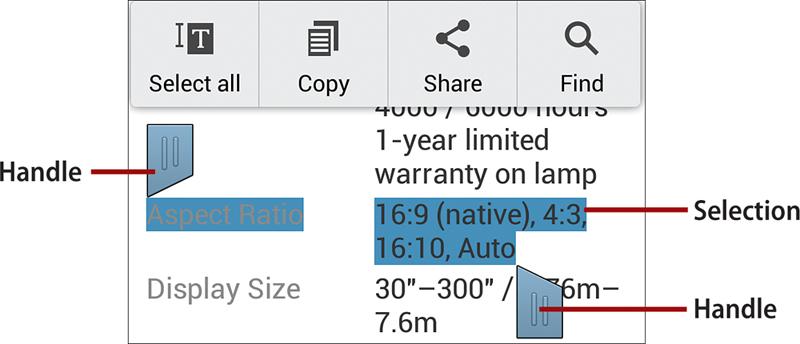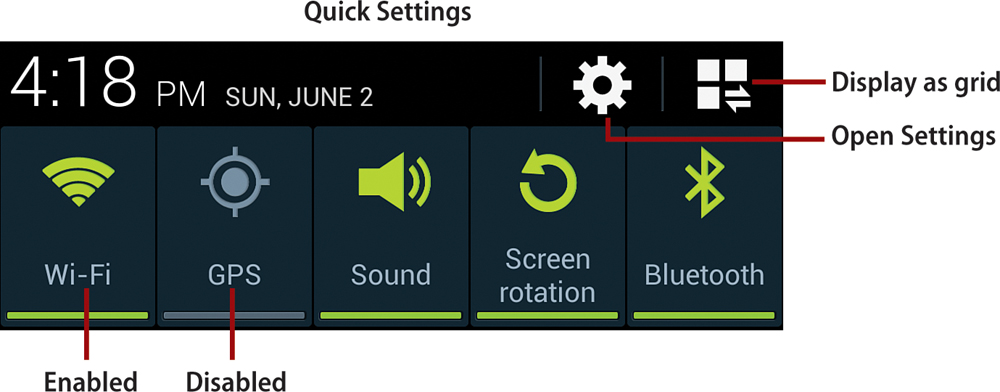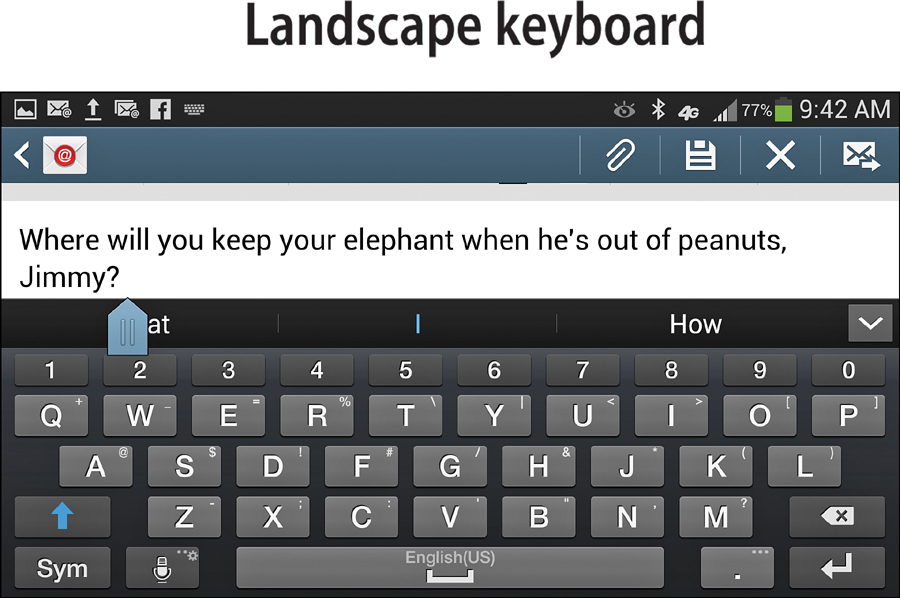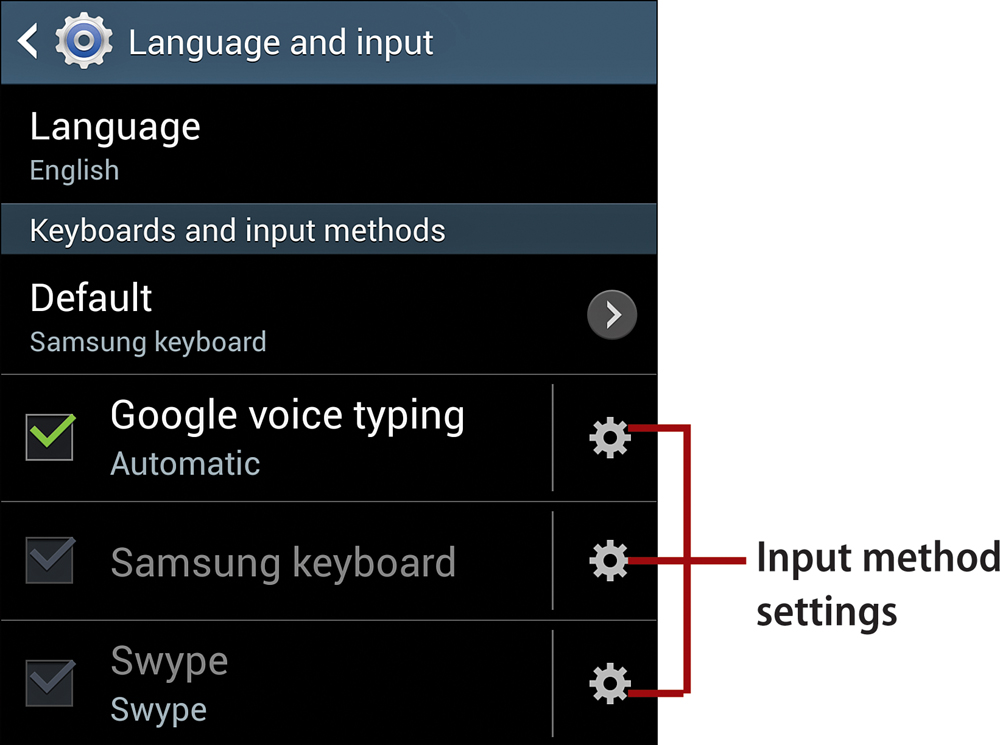2. Understanding the Android/TouchWiz Interface
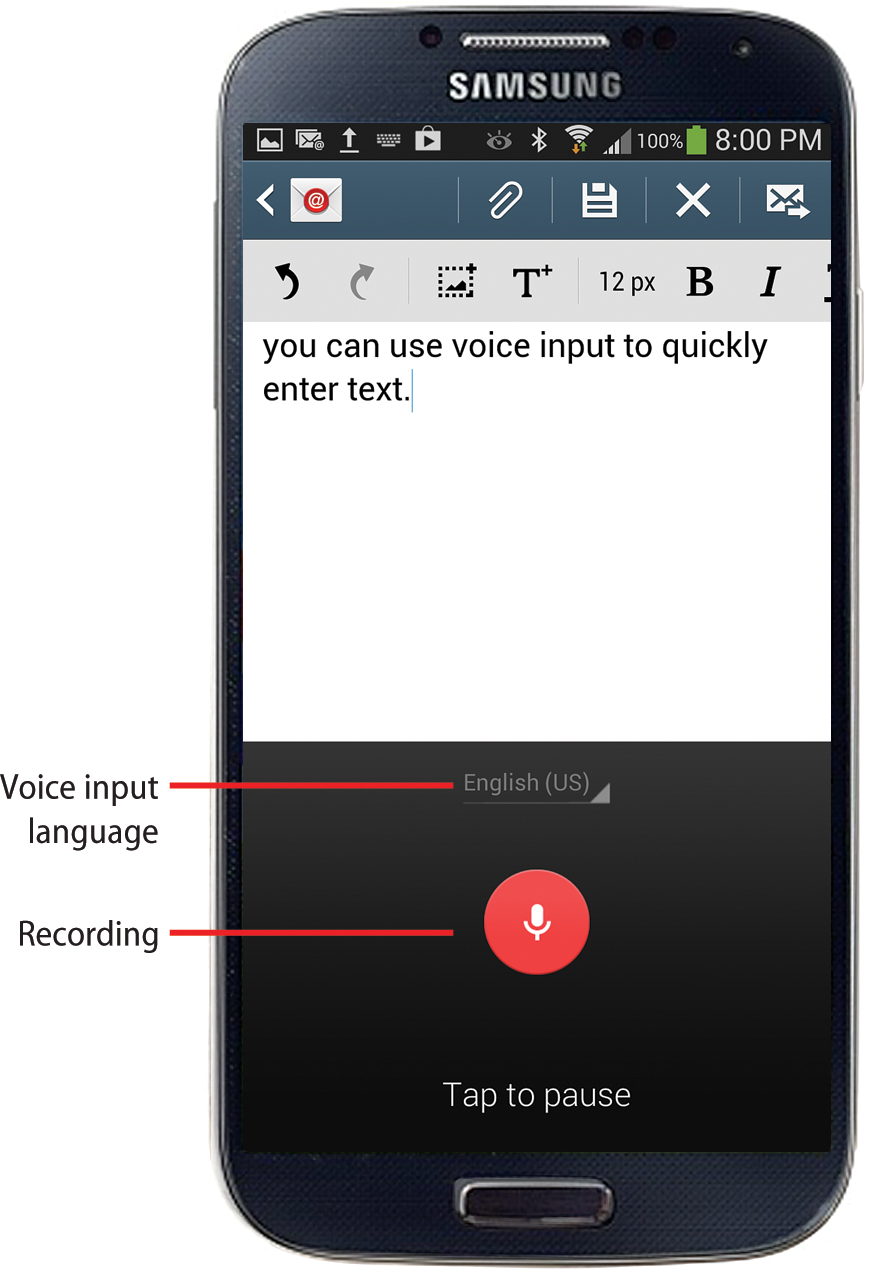
In this chapter, you become familiar with the Samsung Galaxy S 4 interface and discover how to interact with it. Topics include the following:
→ Understanding the Home screen and its components
→ Using the three hardware keys below the touchscreen
→ Working with the Notification panel
→ Tapping and interacting with touchscreen elements
→ Using the onscreen keyboard and voice input to enter and edit text
The Galaxy S 4 has a touch-sensitive screen (or touchscreen) that can detect location, pressure, and motion on its surface. The Android operating system and Samsung’s TouchWiz modifications to it determine how the phone and its applications react to the various touches. Even if you’ve previously owned an Android phone or another touch-sensitive device, such as an iPod touch or a tablet, you need to be familiar with the information in this chapter. Read on for the essential methods of interacting with the touchscreen and the hardware keys below the screen, as well as the techniques for entering and editing text.
The Home Screen
The Home screen is Command Central for your phone. You launch apps (applications) from this screen, view the latest information presented on widgets (such as the local weather from AccuWeather.com), and initiate phone calls and messaging sessions.
The important parts of the Home screen include the status or Notification bar, the main area (equivalent to a PC or Mac desktop), Home screen indicator, and icons for five primary shortcuts (Phone, Contacts, Messaging, Internet, and Apps).
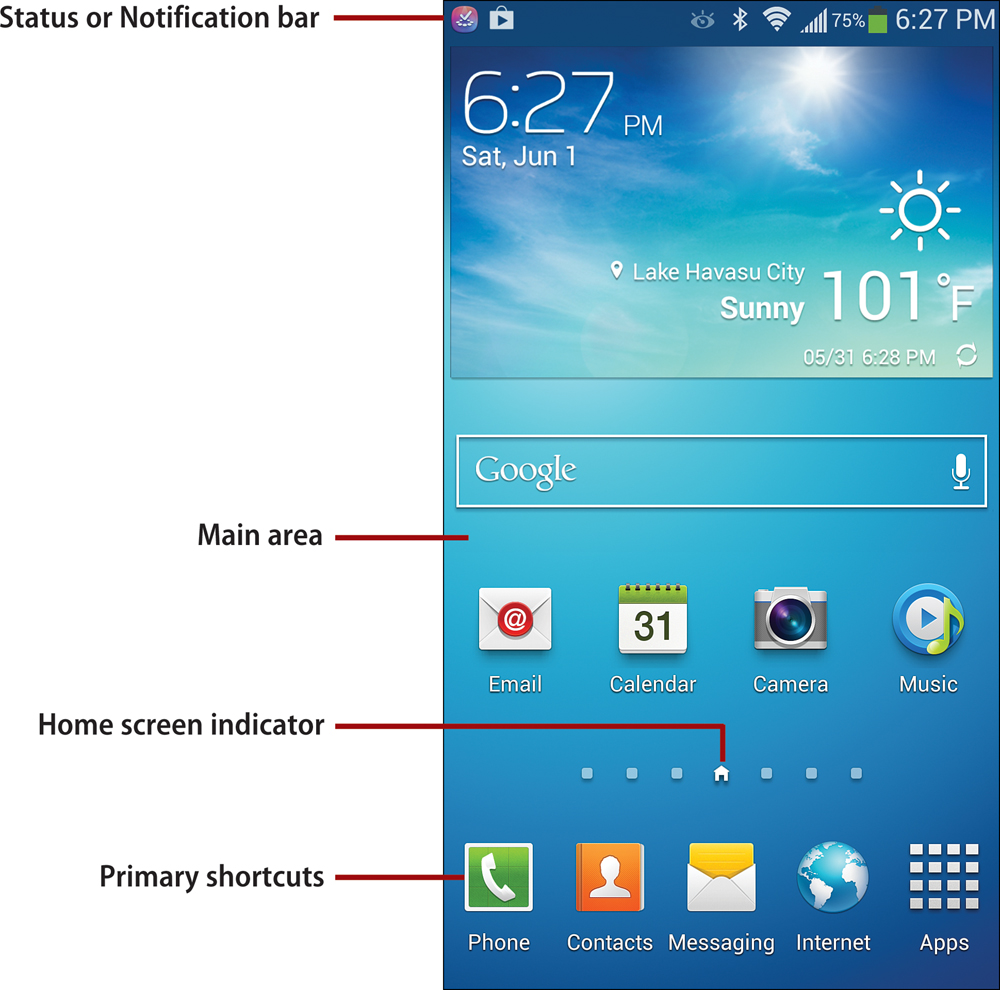
The Status or Notification Bar
The status or Notification bar at the top of the screen serves two functions. First, icons on the right side of the bar show the active communication features (such as Wi-Fi, 3G/4G, Bluetooth, and GPS) and display status information (such as the current battery charge and Wi-Fi signal strength). Second, the left side of the bar displays notification icons for important events, such as new email, new text messages, missed calls, and downloaded or uploaded items.
Although it might be tempting to do so, you can’t interact with the bar; tapping its icons does nothing. To change the active features or respond to notifications, you use the Notification panel (described in “The Notification Panel,” later in this chapter).

Main Area
The Home screen is yours to embellish as you like. As you can see, you can place widgets and shortcuts wherever you want, as well as choose a custom background (wallpaper) for it, as explained in Chapter 3.
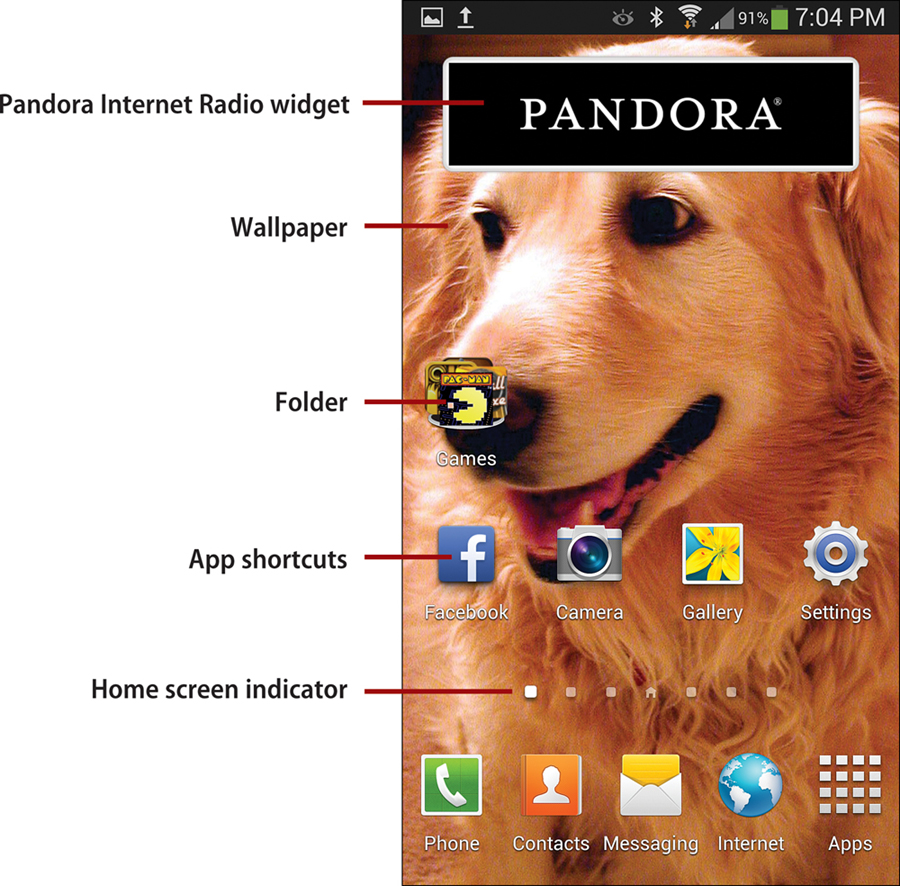
Extended Home Screen
The Home screen actually consists of up to seven different screens or pages, each represented by a Home screen indicator. As with the center Home screen page, you can add different widgets and shortcuts to each page. To move from one page to another, do any of the following:
• Press the Home key to go directly to the main Home screen page.
• Tap the Home screen indicator of the page that you want to view.
• Swipe left or right to flip to the desired page.
• Drag a Home screen indicator to the left or right to see a visual and numeric representation of each Home screen page.
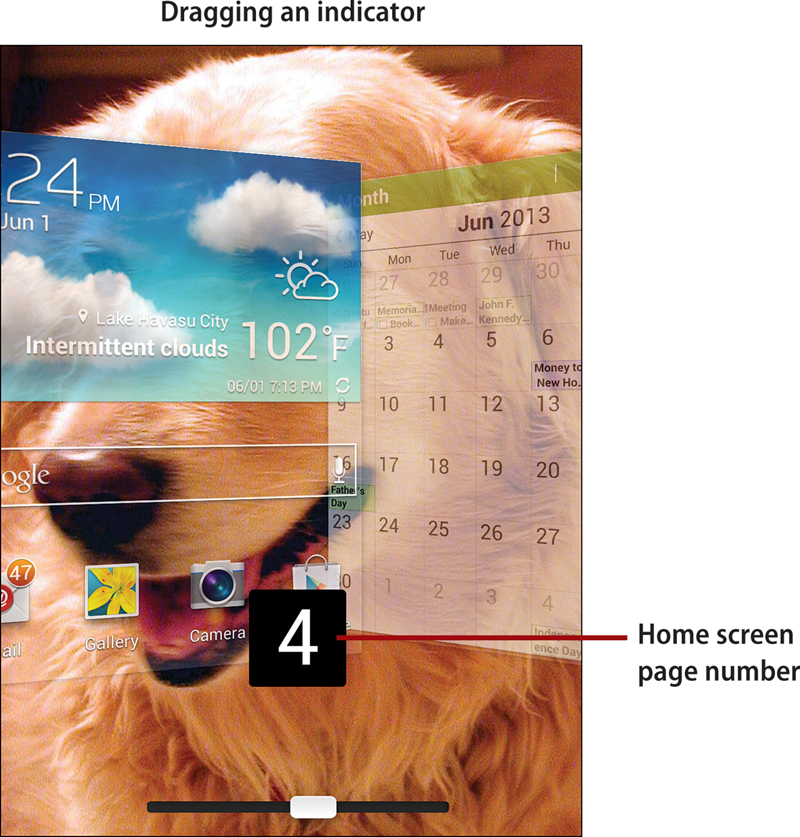
As explained in Chapter 3, you can rearrange the Home screen pages, add new ones (up to the maximum of seven), and delete unwanted ones.
Setting the Home Screen Mode
To make it easier for new smartphone (or Android smartphone) users to become comfortable with their Galaxy S 4, the Home screen can be changed from Standard mode (which is the focus of this book) to the simpler Easy mode. Easy mode provides:
• Three simple Home screen layouts with larger icons and text
• Large, easy-to-read text in important apps, such as Contacts, Calendar, and Phone
• Fixed shortcuts to 12 essential apps and the option to add 3 more of your choosing
• Three fixed widgets (time, date, and temperature)
• Access to all additional apps as a scrolling alphabetical list
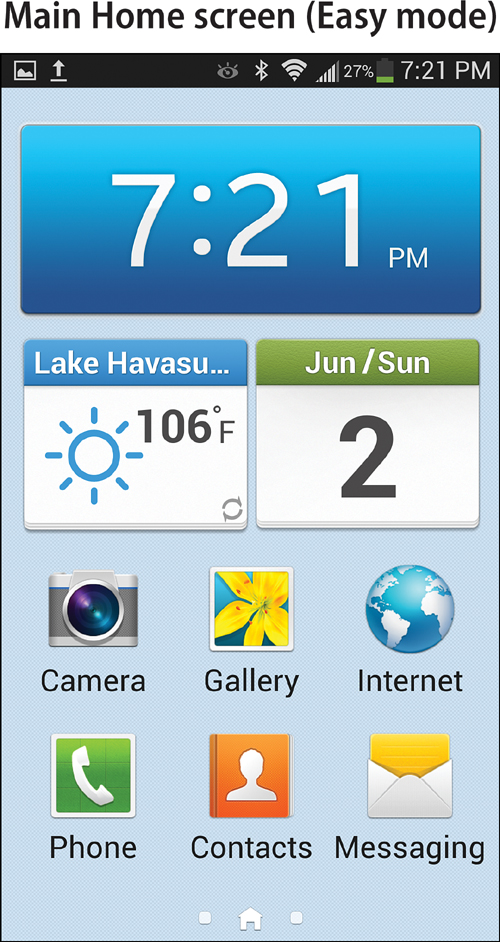
You can switch between Standard and Easy mode whenever you like. Customizations that you’ve made to the Home screen pages in either mode are restored when you return to that mode. To change Home screen modes, follow these steps:
1. On the Home screen, tap Apps, followed by Settings.
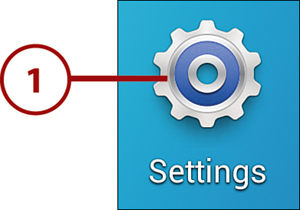
2. Select the My Device tab, and tap Home Screen Mode.
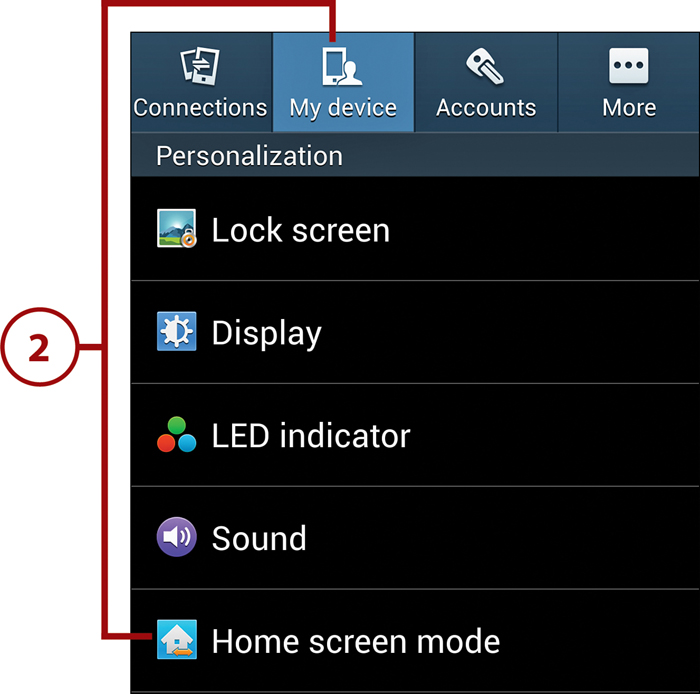
3. Select a mode (Standard or Easy), and tap Apply. Tap OK in the confirmation dialog box.
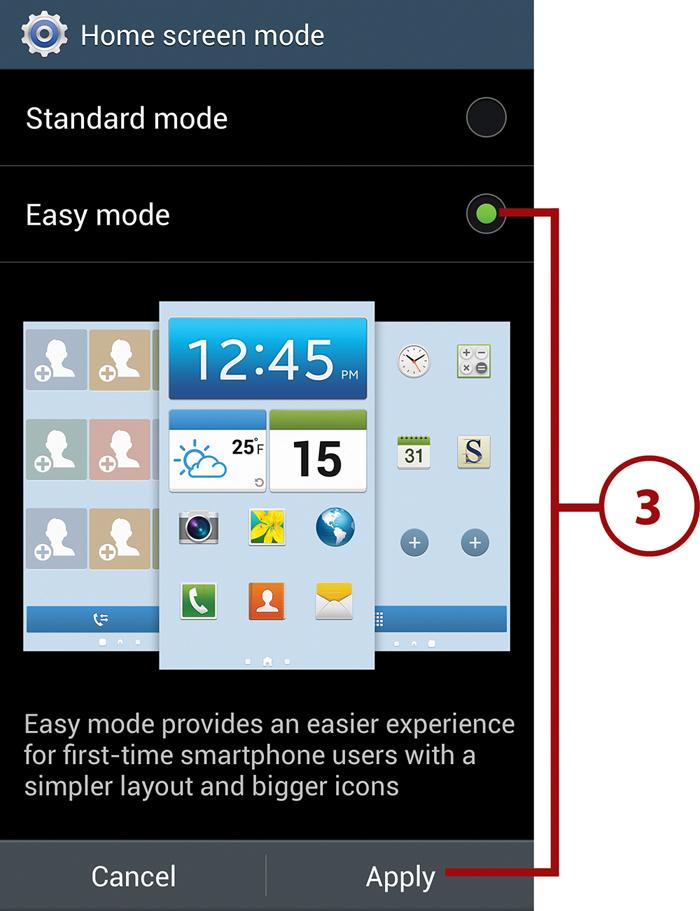
Other Screen Indicators
The indicator dots in Apps and Widgets work in the same manner as they do on the Home screen pages. Each dot represents a screen or page of icons. The lit dot indicates the screen or page that you’re viewing.
Primary and Other App Shortcuts
Beneath the indicator dots on every Home screen page are icons for Phone, Contacts, Messaging, Internet, and Apps. These are known as the primary shortcuts. With the exception of the Apps shortcut, you are free to remove, reorder, or replace the first four. If, for example, you seldom use Messaging, you can replace its shortcut with one for Email, Settings, or another app that you constantly use, such as Angry Birds or Facebook. See “Repositioning and Removing Home Screen Items” in Chapter 3 for instructions.
Depending on your carrier, you may see additional app shortcuts above the indicator dots on some Home screen pages. Like the primary shortcuts—as well as other shortcuts that you add to any Home screen page—you can freely remove, reorder, or replace these shortcuts.

Using the Hardware Keys
There are three ever-present hardware keys located directly below the touchscreen: Menu, Home, and Back. When pressed, each key performs a context-sensitive function related to the operating system (when viewing the Home screen) or the app that you’re currently using.
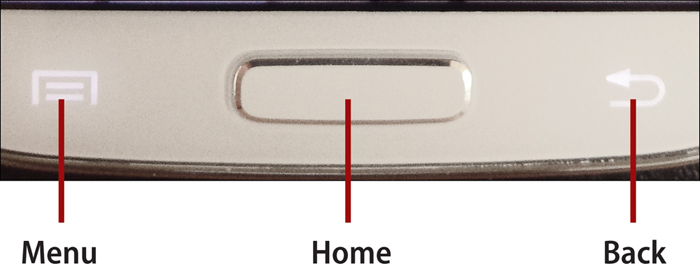
Menu Key
As its name implies, when you press the Menu key, a menu of options or commands may appear. When you press the Menu key on the Home screen, the menu presents options for creating a folder, setting preferences, and so on. When you press the Menu key within an app, the menu’s contents are set by the developer and frequently vary depending on the part of the app that’s active.
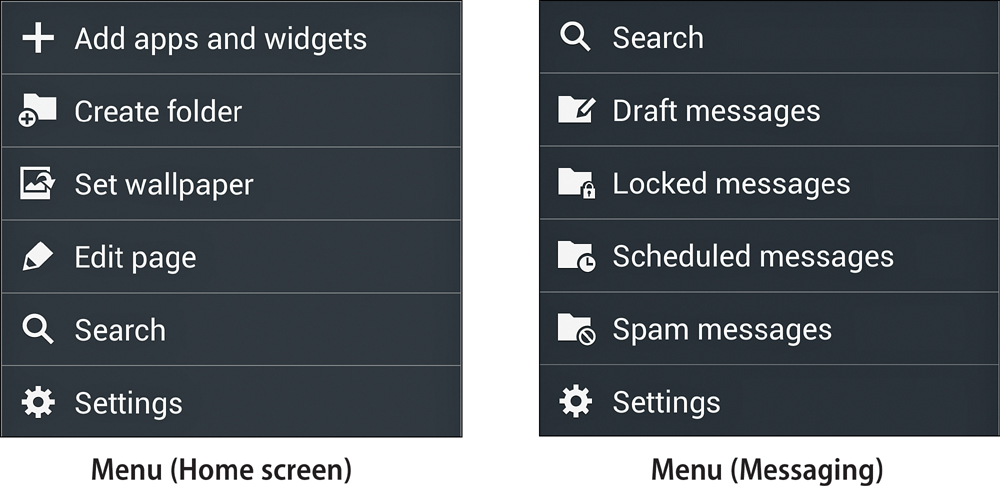
Home Key
The Home key has multiple functions, depending on whether you’re on the Home screen or using an app. You can also use it in combination with the Power button to take screen shots (as described shortly).
Within an app. Press the Home key to exit the app and return to the most recently viewed Home screen page. Press and hold the Home key to display a list of recently run and active apps. You can tap any app thumbnail to launch or switch to that app.
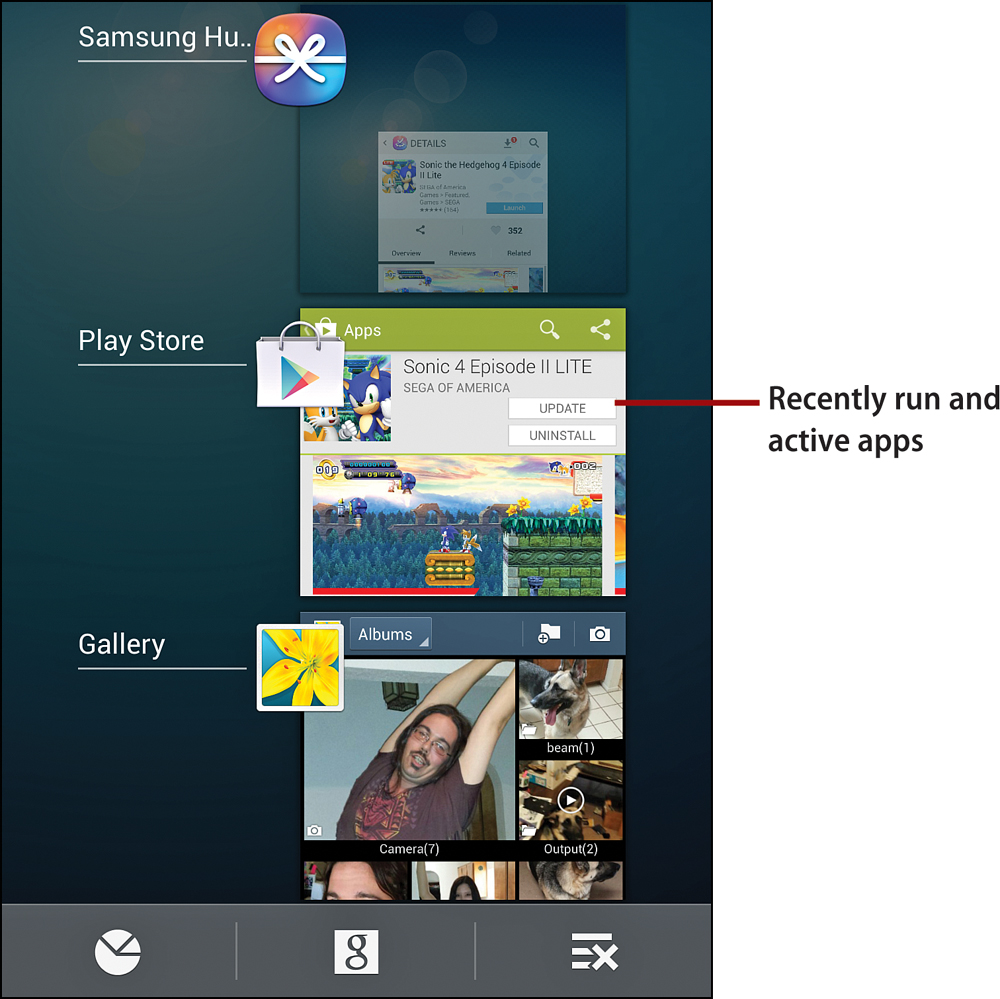
On the Home screen. When you press the Home key while viewing any Home screen page, it displays the main Home screen page. Press and hold the Home key to display a list of recently run and active apps. You can tap any thumbnail to launch or switch to that app or system component. If you quickly double-press the Home key, S Voice is activated. See “Using Voice Services” in Chapter 3 for information about using S Voice.
Within an app or on the Home screen. If you simultaneously press and hold the Home key and Power button, the phone performs a screen capture, creating a graphic image of the screen. All captures are saved in the Screenshots folder and can be viewed in Gallery. You can also perform a screen capture by dragging the side of your hand across the screen.
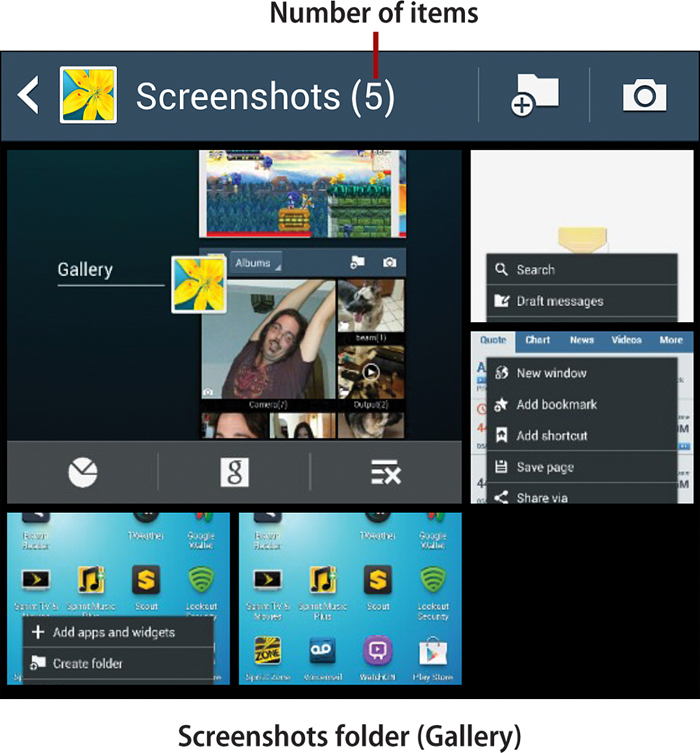
Back Key
You use the Back key within apps to return to the previous screen or—if on the app’s initial screen—to exit to the Home screen.
Within an app. Press the Back key to return to the previous screen. If you press it on the app’s initial screen, you exit the app and return to the most recently viewed Home screen page.
Within Internet and Chrome. Press Back to display the previous web page. The Back key has the same function as pressing Backspace (Windows) or Delete (Mac) when using a web browser.
Within a dialog box or an options menu. Similar to pressing the Escape key in many computer programs, you can press Back to exit a dialog box or options menu without making a choice.
When typing. Press Back to dismiss the onscreen keyboard.
Within the Notification panel. Press Back to dismiss the panel.
The Notification Panel
When new notifications appear in the status bar announcing received email, text messages, software updates, and the like, you can display the Notification panel and optionally respond to or clear the notifications.
1. Open the Notification panel on the Home screen or within most apps by touching the status bar and dragging downward.
2. Tap a notification to respond to or interact with it. For example, tapping a New Email notification launches Email and displays the Inbox. When you respond to a notification, it’s removed from the Notification panel.
3. To remove a notification without responding to it, drag it off the screen to the left or right. To simultaneously remove all notifications, tap the Clear button.
4. To close the Notification panel, touch the gray bar at the bottom of the screen and drag upward.

Interacting with the Touchscreen
Your phone has a touch-sensitive screen that you interact with by tapping, touching, and making other motions with your fingers or hand. In addition, within many apps, the phone recognizes and responds to the angle at which it’s being held or its proximity to nearby objects.
Using Your Fingers
You can interact with the touchscreen by doing any of the following:
• Tap. To launch an app, open a document, choose a menu command, select an item in a list, activate a button, or type characters on the onscreen keyboard, tap the item lightly with your fingertip. (A tap is equivalent to a mouse click on a computer.)

• Touch and hold (or press and hold). You can interact with some items by touching and holding them. For example, touching and holding a person’s record in Contacts causes a contextual menu to appear that enables you to do something with the record, such as edit or delete it. To move or delete a Home screen item (such as a shortcut or widget), you can touch and hold the item.

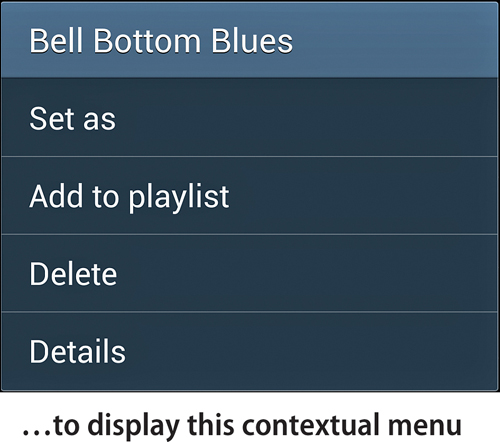
• Flick. Scroll up or down through a lengthy menu or any vertical list of items (such as a message list in Email) by making light, quick vertical strokes.
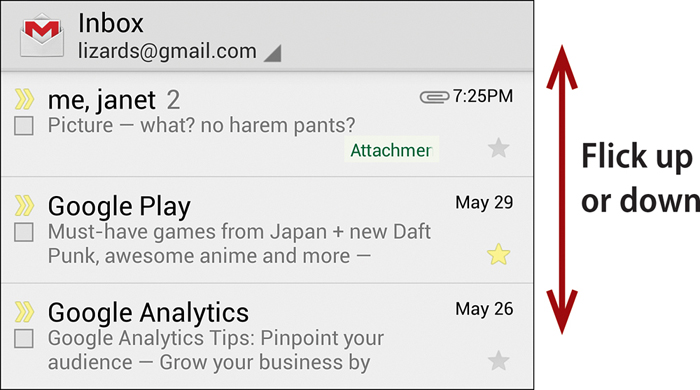
• Swipe. A swipe is the horizontal equivalent of a flick. Swipe to flip through images in a Gallery folder, view different Home screen pages, and move through the Apps and Widgets pages.
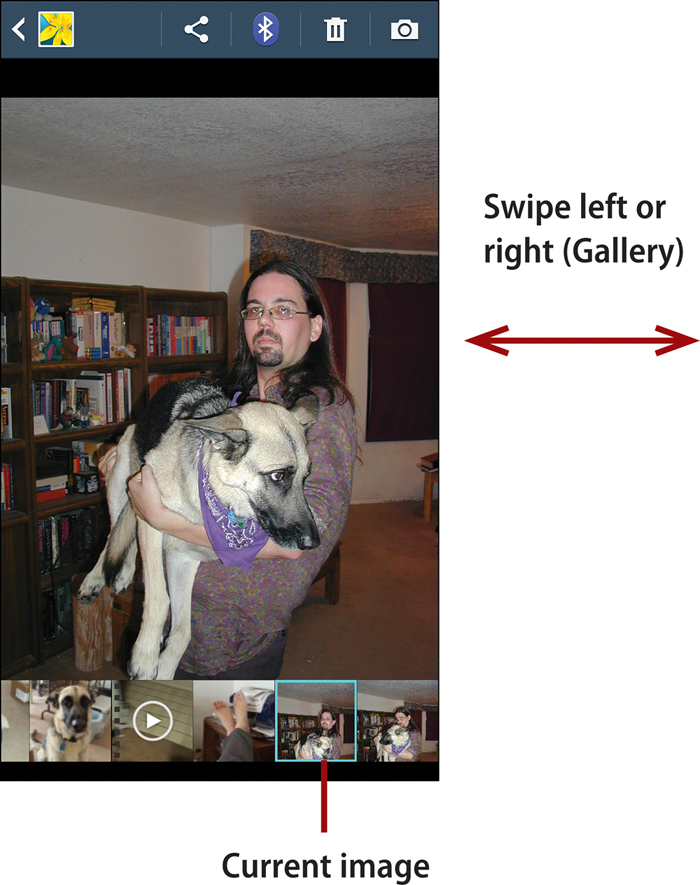
Try a Double Tap
In certain apps (Gallery, Internet, and Chrome, for example), you can also double-tap the screen to zoom in or out. Spreading and pinching, however, provide better control over the amount of magnification.
• Drag. To move an item (such as a widget or app icon on the Home screen), press and hold the item, and don’t release it until it’s in the desired position—on the current screen page or a different one.
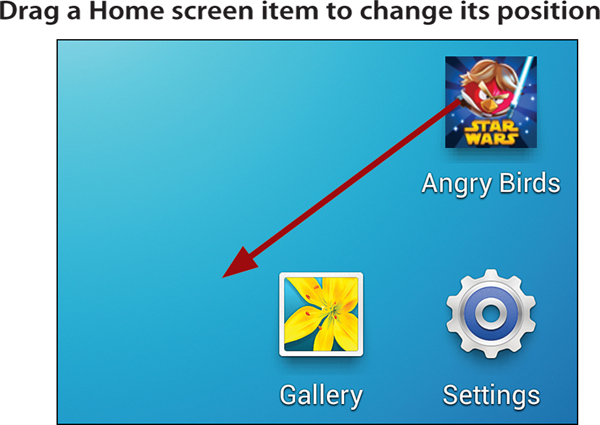
• Spread/pinch. To zoom in or out (increasing or decreasing the magnification) when viewing a photo or web page, place two fingers on the screen and spread them apart or pinch them together, respectively.
Rotating the Screen
In many apps, you can rotate the screen to change from portrait to landscape orientation and vice versa. It’s extremely useful when viewing photos in Gallery that were shot in landscape orientation, when reading web pages in the Internet or Chrome app, and when you need to type on the onscreen keyboard, for example.

Entering Text
In addition to simply viewing and listening to content on your phone, much of what you do involves entering text. You can enter text using the onscreen keyboard or by speaking into the phone.
Using the onscreen keyboard, there are two methods of typing. You’re familiar with the first one in which you tap letter, number, and punctuation keys as you would on a computer keyboard or a typewriter. The second uses software called Swype, in which you drag your finger over the keyboard—touching the characters needed to spell each word.
Using the Keyboard: Tapping
1. Tap to select a text field or box, such as the Internet address box, a password field, or the message area of a text message. The onscreen keyboard appears. A blinking text insertion mark shows where the next typed character will appear.
2. Tap keys to type.

Entering Nonalphabetic Characters
Tap the SYM key. The key above it is now labeled 1/2, and the layout displays numbers, currency symbols, and common punctuation. Tap this key again to cycle to the symbol (2/2) layout. To return to the alphabetic layout, tap the ABC key.
3. To dismiss or hide the keyboard, perform the action necessary to complete your typing (such as tapping Send) or press the Back key. To restore the keyboard after pressing Back, tap in the text box or field again.
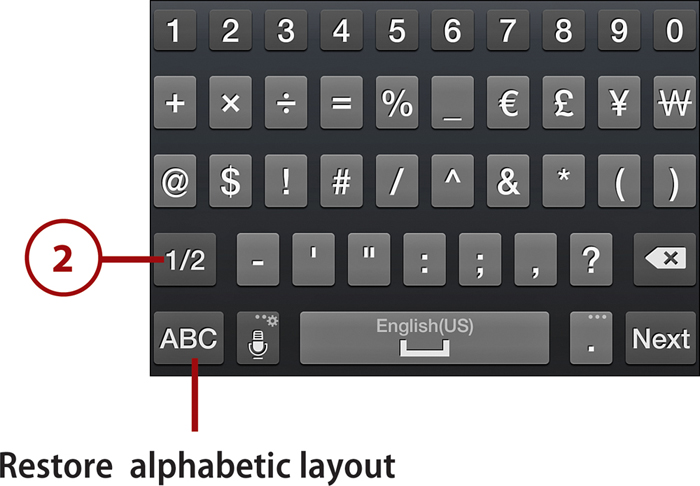

Capitalization
When you begin entering text into a field or are starting a new sentence, the first character is typically capitalized automatically. Subsequent capitalization is determined by the state of the Shift key. Tap the Shift key to toggle it among its three states: lowercase, capitalize next letter only, and capitalize all letters.

Using the Keyboard: Swype
1. Tap to select a text field or box, such as the Internet address box, a password field, or the message area of a text message. The onscreen keyboard appears. A blinking text insertion mark shows where the next entered character will appear.
2. To type each word, drag over its letters—in order. Complete the word by briefly lifting your finger from the screen and then drag over the letters needed to form the next word. A space is automatically inserted between each pair of words. Tap punctuation where it’s needed.
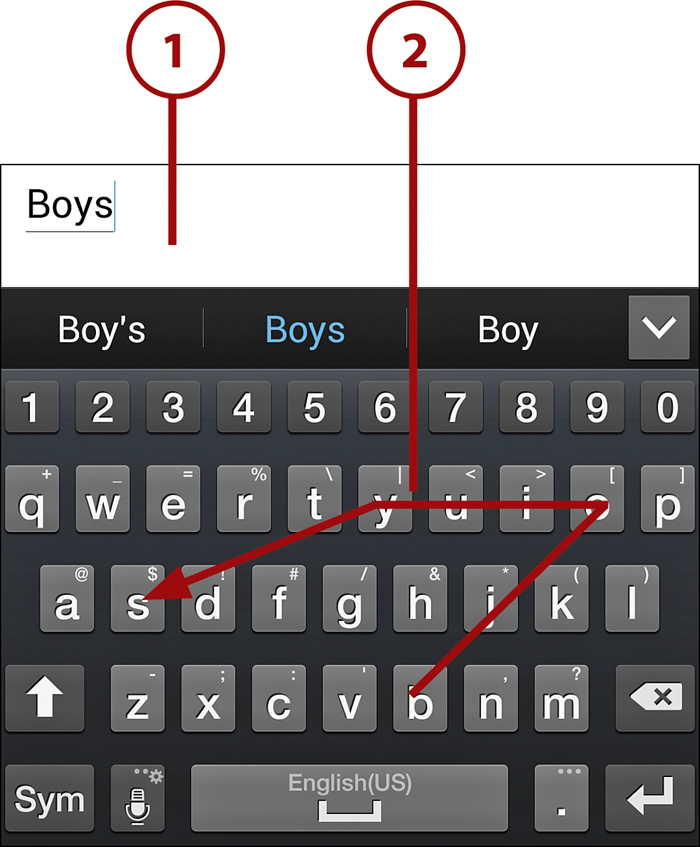
Duplicate Letters
If a letter is repeated in a word, such as l in follow, make a loop over the letter or scribble over it to indicate that it’s repeated.
Using Voice Input
If you’re abysmal at using the onscreen keyboard and are unwilling to take the time to master it, voice input (also called voice typing) may be more to your liking. You speak what you want to type, and it’s translated into text.
1. To enable voice input, press and hold the multi-mode key and select voice input—the microphone. If the multi-mode key already displays the microphone, simply tap it.

Switch Using the Notification Panel
As explained earlier in the chapter, you can also switch input methods by opening the Notification panel, tapping Select Input Method, and selecting Google Voice Typing in the dialog box.
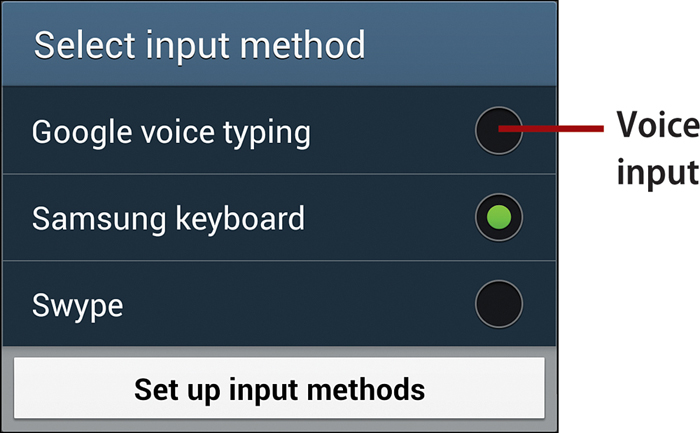
2. A recording indicator appears. Speak the text, saying punctuation (such as comma, period, question mark, and exclamation point) where it’s needed. The text is transcribed as you speak.

3. When you finish recording, tap the recording icon and then tap the keyboard icon.
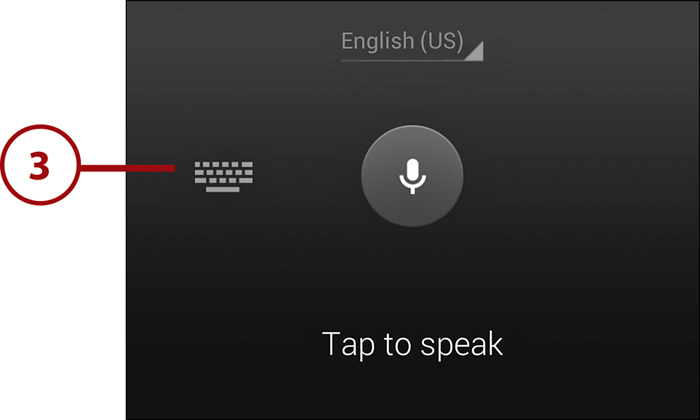
4. Any instance of questionable transcription is marked with a faint gray underline. To view and select possible corrections, tap the underlined text.

Editing Text
Typos, missing capitalization and punctuation, and bad guesses in Swype or voice input are common in entered text. Instead of just tapping Send and hoping your message recipient will know what you mean, you can edit the text by doing any of the following:
• At the blinking text insertion mark, you can type or paste new text or press the Delete key to delete the character to the left.
• To reposition the text insertion mark for editing, tap in the text. If the text insertion mark isn’t positioned correctly, carefully drag the blue marker to the desired spot.
• To select a single word for deletion or replacement, double-tap or long-press the word. To delete it, tap the Delete key; to replace it, type over it.
• To select a specific text string (a word, sentence, or paragraph, for instance), start by selecting a word at the beginning or end of the text that you want to select. Drag the selection handles to highlight the desired text. Then select a command from the pop-up menu above the selection, press the Delete key, or overtype the selected text. (Note that the command icons, their appearance, and whether they’re labeled varies from one app to another. If there are more icons than can be shown at once, they scroll horizontally.)

• To paste the most recently copied or cut text into a text box, set the text insertion mark, tap the blue marker, and then tap Paste in the pop-up that appears.
• When entering and editing text in Email or Gmail, you can tap icons on the toolbar above the message area to insert images, apply character and paragraph formatting, or undo the most recent change.

Pasting Other Material
If you select Clipboard from the pop-up menu rather than Paste, you can paste other material—images, for example—that you recently copied or cut. Tap the item that you want to insert. To remove an unwanted item from the Clipboard, press and hold the item, and tap Delete from Clipboard.
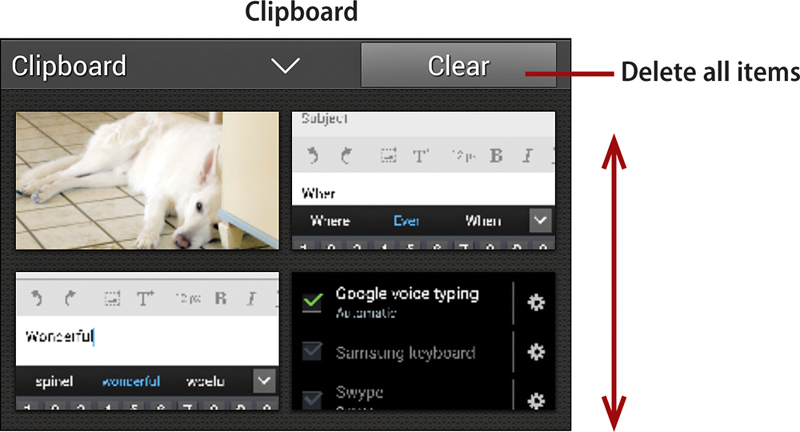
Copying Text from a Web Page
You can also use editing techniques to copy text from a web page. Press to select the first word, and then drag the handles to select the material to copy. In the toolbar that appears, tap Copy to copy the material so that you can paste it elsewhere, or tap Share to copy the material directly into a new email, text message, or Facebook post, for example.
